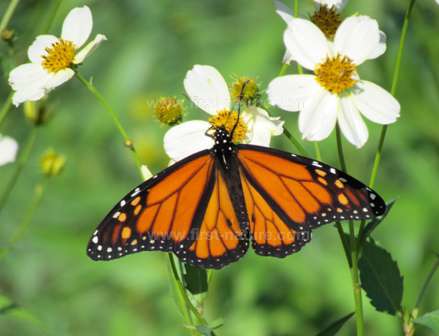Wildlife and Ecology Prospects, October to December inclusive
Wildflowers - Fungi - Insects
What to look out for late in the year in the Algarve
Wildflowers
Stumbling across a wild orchid at this time of the year comes as a great surprise.
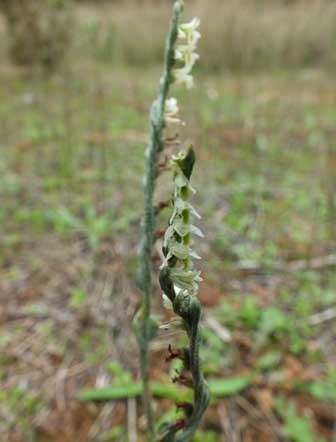
Above: Autumn Lady's-tresses flowering beside the Quarteira river close to Paderne in mid-November.
The elusive Algarve autumn-flowering orchid
Most of the Algarve's beautiful wild orchids flower in early spring but there are two exceptions and both are rare and difficult to spot. These two orchids, Summer Lady's-tresses Spiranthes aestivalis and Autumn Lady's-tresses Spiranthes spiralis are closely related. Summer Lady's-tresses flowers in shady margins of rivers and streams in June, and Autumn Lady's-tresses flowers in the same type of habitat but waits until the first rains of autumn to arrive and then pops up along the edges of our water courses or in other moist and shady locations.
Although these orchids look remarkably similar to the casual observer they are easy to tell apart because of their very different flowering times. Close inspection also reveals that the inflorescences are different in appearance too. In the case of Summer Lady's-tresses the small white flowers protrude horizontally from the stem, but with Autumn Lady's-tresses the flowers open in a tight spiral around the very hairy stem.
Summer Lady's-tresses are particularly rare in the region but have been recorded close to Caldas de Monchique. Autumn Lady's-tresses are more widespread (but not easy to find) and are reported from the banks of the River Algibre and lower down in the valley where the Algibre joins the River Quarteira in the area of Paderne. Sand dunes are also a good place to look for Autumn Lady's-tresses and Carrapateira is one of the best. The orchids grow in small pockets at the base of the dunes where they are able to catch moisture which seeps down through the sand during rain and collects, enabling them to commence their growing and flowering cycle.
Fungi
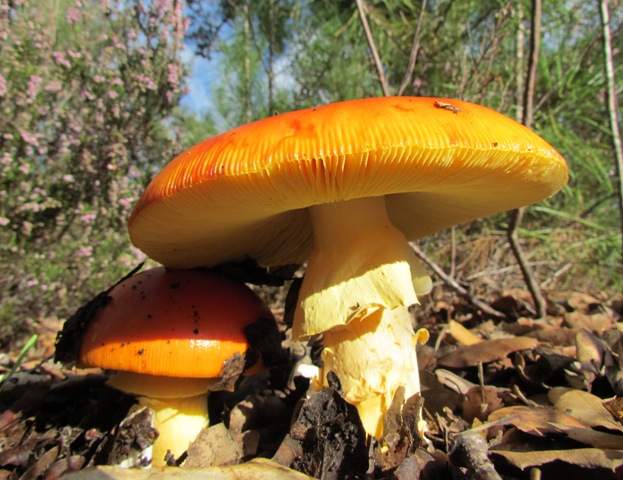
Caesar's Mushroom - one of the delicious edible species to be found in the Algarve
Safety First - Sue Parker
In the ups and downs of foraging for food, fruitless searches are compensated by those magical moments when you find something very special. That’s when hasty harvesters can make ghastly gaffes, the worst of which may prove fatal. ‘Caring to inspect before daring to ingest’ ensures you enjoy your present find and live to enjoy future ones.
Superficial similarities between something that is delicious and good to eat and something else that is poisonous lure people to their deaths every year. It’s not just those who are starving and desperate for food who take such risks. In Europe hundreds die each year as a result of eating fatal fruits or toxic toadstools. What’s particularly sad is that the very finest and most abundant of free food is not difficult to identify with certainty; you just have to know how to unmask the fraudsters.
Take Morels, Morchella esculenta, for example – I do, eagerly, any time I am lucky enough to find them. If you are making a mushroom sauce to go with red meat, there is no finer mushroom, but it’s crucial to know what False Morels can do, and even more importantly what they look like.
The Algarve is a top destination for those interested in fungi, but water is the vital ingredient required to stimulate their fruiting bodies to appear. Pat O'Reilly reports:
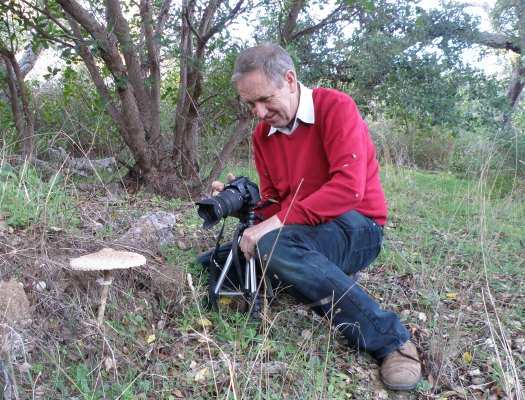
Pat photographing a Parasol Mushroom in forest near Monchique
There are very few places where fungi cannot grow, but mixed woodlands and unimproved grassland habitats are usually the most productive. In dry weather concentrate on the borders of rivers and streams and the bottoms of slopes. Even the lawns around villas can provide good displays of colourful fungi provided they are regularly waters and not subject to heavy doses of weedkiller or fertiliser.
Here are some special species to look out for:
Multiplication made Deceptively Simple
Fungi in the mycological family Phallaceae go by the common name of stinkhorns. Some members of the family really do stink. Others hardly smell at all (to us, that is, but as I explain below flies and other insects certainly are lured by their pong) but nevertheless from their shape alone they are instantly recognisable as stinkhorn family 'members'. This is the case with Mutinus caninus, which is commonly referred to as the Dog Stinkhorn… obviously a male dog!
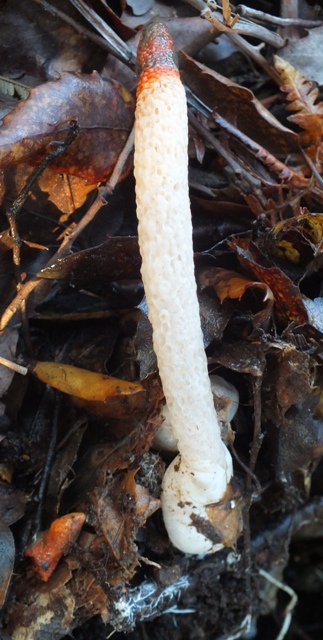
Dog Stinkhorn Mutinus caninus
Dog Stinkhorns are found throughout Europe, but it took 15 years of fungi foraying before we stumbled across this distinctive species in the Algarve; it popped up its sticky green head on Christmas Eve 2015 in cork oak woodlands near Monchique. Insects of various kinds soon cluster on the spore-laden sticky gleba that coats the tips of these stinkhorns, and as the bugs consume the olive-green soup so inevitably a few of the fungal spores stick to their feet. Once a fly takes off after lunch and alights elsewhere in the woods, it leaves tiny sticky footprints from which new mycelia (microscopic thread-like fungal networks) can develop. By this harmless deceit, Dog Stinkhorns and their relatives manipulate insects into helping them to ‘go forth and multiply’ – and no Bitch Stinkhorn is involved!
Here is a link to the Dog Stinkhorn page on our First Nature website…
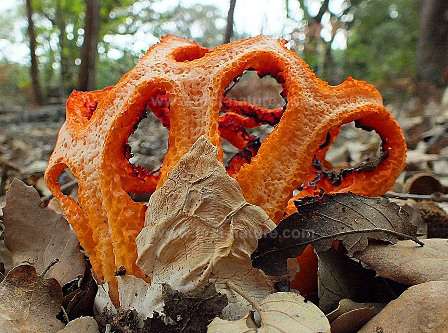
Above: Red Cage fungus is rare in northern Europe but common in the Algarve. They first appear in November but thereafter they can be found well into the New Year.
The first autumn rains will stimulate more of the region's fungi to appear especially in cooler and damper areas, such as the woodlands up in the hills around Monchique. Resembling a bizarre Christmas decoration, Red Cage Fungus Clathrus ruber, which is a member of the Stinkhorn family of fungi, doesn't smell anywhere near as good as it looks. In fact, the obnoxious smell may be the first thing to tell you that you are close to a fruiting specimen. Taking closeup photographs is not for the faint hearted!
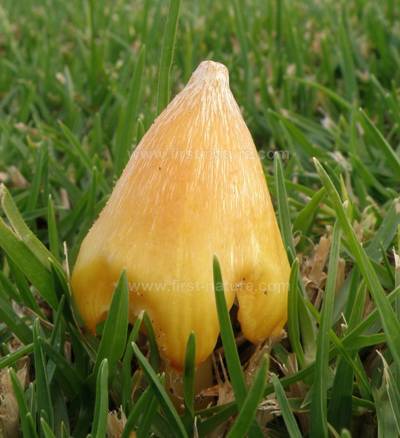
Persistent Waxcap Hygrocybe acutoconica
As the last of the Algarve's floral fireworks fade, so another paintbox colours the countryside with more than a rainbow of hues and shades. Fungi! Up they pop when the autumn rain arrives, and off to work they go recycling the deadwood of forests and the frazzled plants of pastures and parks, and playing other important and sometimes troublesome roles too.
Many lawn mushrooms are fickle, here-today-gone-tomorrow types, but one group. known as waxcaps, tends to hang around. Most persistent of all is a beautiful yellow-orange conical mushroom known as, er... the Persistent Waxcap. Its scientific name is Hygrocybe acutoconica. The cap of this mushroom always feels damp, and in shape it is acutely conical - there, we have translated that latinised (scientific) name with no great difficulty. They're not always so obvious.
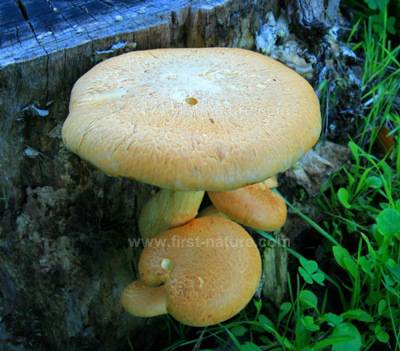
Spectacular Rustgill Gymnopilus juonius
Into the woods now, and what have we got here?. Spectacular smooth-capped orange mushrooms sprout from the stumps of felled trees and occasionally from the trunks of living (but poorly) trees. They are very fond of oaks, but if oak trees are not on the menu these hungry mushrooms will make do with pines. Their scientific name is Gymnopilus junonius.
The prefix Gymn- means bald, while -pilus means a head. It does have a bald (smooth, that is) head or cap, but what about junonius? It is not description; it's a dedication to the Roman goddess Juno. Don't ask why... Until quite recently this spectacular mushroom with rusty-brown gills went by the scientific name of Gymnopilus spectabilis. Much clearer! Oh... its common name is Spectacular Rustgill.
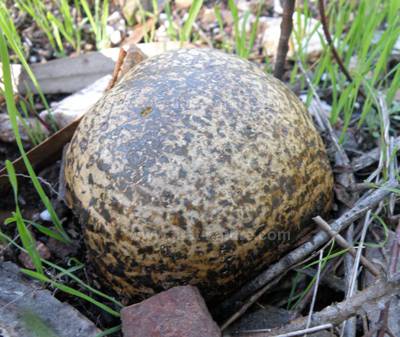
Dye Ball Pisolithus arrihzus
One more for the road... although I hope it doesn't pop up in any road you have to drive along. When it first emerges above ground Pisolithus arrhizus (let's not fret over the meaning of the scientific name!) looks like a ball of horse dung. Inside it are hundreds of white chunks of fungal material looking like grains of rice packed tightly together, and over a month or two they turn olive-green and then reddish-brown until the fungus splits open to reveal (and release) a powdery mass of spores. In the past this fungus was used to dye fabrics - that's why its common name is the Dye Ball - but it has a much more important role nowadays. This is one of the so-called 'mycorrhizal' fungi that link up with the roots of trees and supply them with water and nutrients essential for their healthy growth. In return the fungus receives some of the sugar that the tree produces by photosynthesis. The Dyeball fungus is highly valued by foresters because it can enable young trees to grow on soil so poor or contaminated that few plants could survive there. Pisolithus arrhizus has one other special characteristic: it is tough eniough to tear up tarmac roads and even to crack concrete pavements.
More on Algarve fungi species....
Insects
Sue Parker reports on why the Monarch Butterfly is a surprising and wonderful addition to the wildlife of the Algarve.
Above: crowd puller. This majestic male Monarch butterfly is a real cracker.
Butterflies from the New World sometimes wander across the Atlantic Ocean and spend the rest of their brief lives in Europe. One of the most spectacular of these migrants delights in the scientific name of Danaus plexippus. There is little wonder that this graceful butterfly has been given the name Monarch. With a bit of dective work this species can be found in good numbers on warm, calm days in November. The trick is to find a spot where there are plants for both the adults and larvae to feed on.
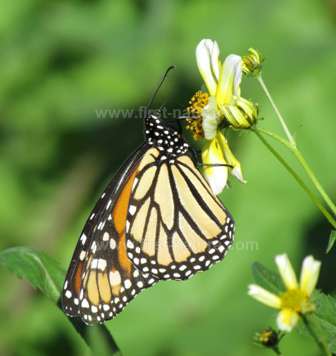
Often slightly smaller than her mate, the female Monarch has heavier wing veining, particularly noticeable in this under-wing view.
In the Rocky Mountains, their North American summer heartland, Monarch butterflies cannot survive the long harsh winters. They solve this problem by heading off down south as the days shorten. From the western side of the continental divide they fly to California, while eastern Rocky Mountains Monarchs flock in their millions to Mexico, a staggering 4000km migration. (Theirs is a one-way ticket, but their offspring will follow the spring northwards up the USA.) These butterflies survive such enormous journeys because they can pause to rest and feed along the way.
For Monarchs to reach the Algarve, they must travel some 6000km, mostly over the Atlantic Ocean with no chance of B&B to break the journey. Only the high flyers make it, relying on wind power rather than wing power. By jet plane it is usually a fourteen-hour flight from Denver to Faro, but a strong tail wind can knock an hour or more off the journey. Monarch butterflies carried along by a 30 knot west wind would take about four days to make landfall here in the Algarve, and the survivors are rewarded by finding their favourite food, close relatives of the milkweeds on which they fed as caterpillars. That, experts are convinced, is why we have resident Monarch butterflies, and they cope very well with our weather all year round, finding nectar to sustain the adults and food for several broods of larvae too.
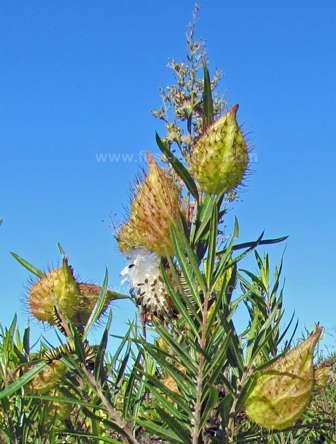
The gooseberry-like seedpods of the Bristle-fruited Silkweed burst open around Christmastime to release seeds each with a fine silky parachute. Look closely and you should spot a few green, brown and white stripy Monarch caterpillars and the blackened larval shucks from which adults have emerged
Another alien, the Bristle-fruited Silkweed Gomphocarpus fruticosus from South Africa, is a close relative of the Aesculus milkweed plants that sustain larval Monarchs in America. Without this imported plant, most years there would be none of these butterflies in the Algarve. That such a beautiful butterfly finds this lanky but otherwise unspectacular plant attractive only underlines the fact that there is no accounting for taste. But there is more to Bristle-fruited Silkweed than meets the eye, and it is very much a matter of taste; the leaves contain some very nasty toxins to which, fortuitously, Monarch larvae are immune but most vertebrate creatures are not. We are what we eat, as the saying goes, and those stripy caterpillars are chock full of toxins, which also provide Monarchs in pupal and adult stages with a poison defence against such predators as lizards, frogs and birds.
In mythology Danaus built a ship - supposedly the first - in which he and his family fled to Argos in order to escape from his tyrannical twin brother Aegyptus. I mention this only because until recently it was thought that passage by ship was the means by which Danaus plexippus reached our shores; however, the chances of a Monarch butterfly surviving what would have been at least a 20-day transatlantic journey are very slim indeed.
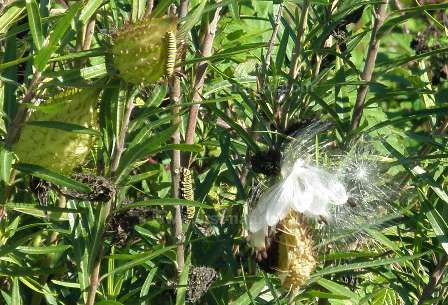
Caterpillars of the Monarch Butterfly in their food plant
What finer Christmas treat can there be than a leisurely after-lunch stroll through Algarve countryside to pay homage to the Monarch. Scan streamsides, ditches and damp meadow margins for Bristle-fruited Silkweed, with their distinctive seedpods. The adult butterflies are not fussy about where they get their nectar from, and fortunately there are always lots of flowers in bloom in the Algarve at Christmas, including garden-escape chrysanthemums on which I have seen swarms of Monarchs.
Please Help Us: If you have found this information interesting and useful, please consider helping to keep First Nature online by making a small donation towards the web hosting and internet costs.
Any donations over and above the essential running costs will help support the conservation work of Plantlife, the Rivers Trust and charitable botanic gardens - as do author royalties and publisher proceeds from books by Pat and Sue.
